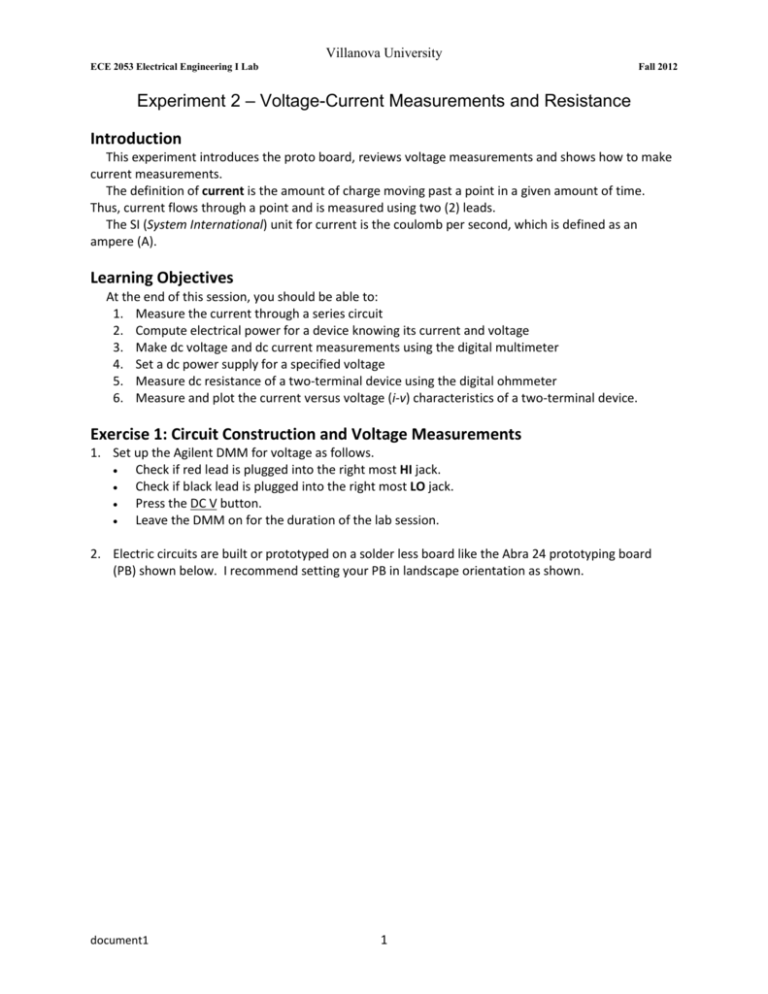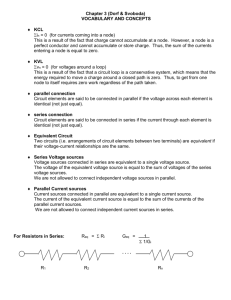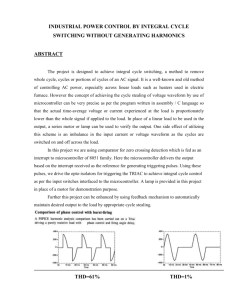2. Voltage-Current Measurements and Resistance
advertisement

Villanova University ECE 2053 Electrical Engineering I Lab Fall 2012 Experiment 2 – Voltage-Current Measurements and Resistance Introduction This experiment introduces the proto board, reviews voltage measurements and shows how to make current measurements. The definition of current is the amount of charge moving past a point in a given amount of time. Thus, current flows through a point and is measured using two (2) leads. The SI (System International) unit for current is the coulomb per second, which is defined as an ampere (A). Learning Objectives At the end of this session, you should be able to: 1. Measure the current through a series circuit 2. Compute electrical power for a device knowing its current and voltage 3. Make dc voltage and dc current measurements using the digital multimeter 4. Set a dc power supply for a specified voltage 5. Measure dc resistance of a two-terminal device using the digital ohmmeter 6. Measure and plot the current versus voltage (i-v) characteristics of a two-terminal device. Exercise 1: Circuit Construction and Voltage Measurements 1. Set up the Agilent DMM for voltage as follows. Check if red lead is plugged into the right most HI jack. Check if black lead is plugged into the right most LO jack. Press the DC V button. Leave the DMM on for the duration of the lab session. 2. Electric circuits are built or prototyped on a solder less board like the Abra 24 prototyping board (PB) shown below. I recommend setting your PB in landscape orientation as shown. document1 1 All holes in this horizontal row are connected together together. All holes in this vertical column are connected together Ground Gutter Notice the red, black, green screw connectors labeled Va, Vb, and the Ground symbol. External electrical sources can be attached to these connectors and then from the connectors to the holes in the PB. Note the horizontal rows of holes between the red and blue lines on the PB. All the holes in each row are electrically connected under the surface of the board. These rows are labeled (+) and (−) and are called power busses. Typically, you connect dc voltage and ground to these busses. The ten horizontal rows labeled AB through IJ are located in a socket strip. Notice the gutter running along the middle. The 5 holes in each column, on either side of the gutter, are electrically connected together under the surface of the board and are considered a circuit node. 3. Obtain a 6 inch piece of wire, two battery units, an Abra 24 prototyping board (PB), and a #47 lamp. 4. Insert the wires of the first battery unit into two holes on the PB. The holes should be in different columns if on the same side of the gutter. 5. Take the second battery unit and insert its wires into holes at different locations on the socket strip. The following illustration shows the two batteries with node numbers N1, N2, N3, and N4 at the ends of the wires. 2 6. Strip the insulation from both ends of the 6-inch wire. Place one end of the wire at node N2 and the other end at node N3. This wiring puts the batteries in series. 7. Measure and record the voltage between nodes N1 and N4 – it should be around 18 volts. 8. Reverse the connections of one of the batteries. 9. Repeat the voltage measurement – it should be close to zero. 10. Remove the wire and connect the #47 lamp between nodes N1 and N2 of the battery unit. The lamp should be on. 11. Measure and record the voltage across the lamp. 12. Is voltage polarity important for the lamp to light? To see, reverse the connections of the lamp. Is the lamp still on? Measure and record the voltage across the lamp. Exercise 2: Current Measurements Using the Digital Ammeter 1. Set up the Agilent DMM as an ammeter as follows. Check if red lead is plugged into the I jack. Note: I stands for current. Check if black lead is plugged into the LO jack. Press the Shift DC I button for dc current measurements. Information on Current Measurement: The tip of the red probe and the tip of the black probe must be inserted in series with the component whose current is to be measured. A positive meter reading means the current is entering the point where the red tip is connected. The unit for current is the ampere and the symbol for the unit is A (upper case). Smaller units of current are: 1 milliampere = 1 mA = 10-3 ampere 1 microampere = 1 μA = 10-6 ampere 2. Place the digital ammeter (DAM) in series with the lamp and battery as shown in the following diagram. Make a copy of the circuit in your notebook. 3. You should observe a meter reading. If not, check your connections. It is also possible that the DAM has a blown fuse – see your instructor. Record the current measurement in milliamperes (mA). 3 Exercise 3: Voltage and Current Measurements of a Lamp A conductive device with two leads can be characterized by its current versus voltage graph. This type of graph is also called its i-v characteristic. Lamps, resistors, and diodes have different i-v characteristics. The lamp characteristic is curvy while the resistor has a straight line characteristic. 1. Remove the 9-volt battery from the circuit. 2. Obtain two 10-inch wires (red and black); strip the insulation from both ends. 3. Connect one end of the red wire to the positive (red) terminal of the Agilent 6-volt source. Firmly screw down the terminal. 4. Connect one end of the black wire to the negative (black) terminal of the Agilent 6-volt source – make it tight. The circuit looks like the following. Make a copy in your notebook. 5. Turn on the power supply (PS). The display shows OUTPUT OFF +6V where OUTPUT OFF means that the 6-volt source is not connected to the front panel connectors. 6. Set the 6-volt source to 6.0 volts as follows. Press the Display Limit button. Rotate the knob to set the blinking digit to 6 – the LMT annunciator should be blinking. Press the right arrow button to move the blinking digit to the right. Rotate the knob to set the blinking digit to 0. 7. Press the Output On/Off button to connect power to the circuit. The ammeter should display a reading. 8. Record the lamp voltage from the PS display. And record the lamp current from the ammeter. Put your data in tabular form. Refer to Table 1 in the Appendix for an example of how to set up a data table. 9. Repeat the measurements for source voltages of 5.5, 5.0, 4.5, …, 0.5, 0.0 volts. Make a note when the lamp goes out and record that voltage and current. 4 10. Make a graph in your notebook with voltage on the abscissa (x-axis) and current on the ordinate (yaxis). Plot your recorded data. Don’t forget to place the point (0 mA, 0 V) on the graph. Draw a smooth curve through all the data points. Label the axes of the graph and place a title at the top of the graph. This graph is the i-v characteristic for the lamp. Show the plot to your instructor. 11. Compute the power absorbed by the lamp for voltages of 3 volts and 5 volts. The results are small so you should convert the result to milliwatts (mW). For example, if voltage multiplied by current equals 0.732 W, then write it as 732 mW. 12. Press the Output On/Off button on the PS to disable the sources. Remove the lamp from the PB. Exercise 4: Carbon Resistors and Resistance Just about every element in an electric circuit has resistance. Resistance is the capacity to oppose electric current flow. The unit of resistance is the ohm. Circuit devices specifically designed to provide this function are called resistors. A carbon-composition resistor (see illustration below) is a generalpurpose resistor, cylindrically shaped, and with two leads; the leads sometimes are called pigtails. The resistors have ohmic values ranging from 1 ohm up to 20 million ohms. Notably, resistors dissipate energy and consequently have power ratings. Carbon resistors have ratings up to 2 watts. The ohmic value can be identified by a color code. Resistance has the unit of ohm and the symbol is Ω. Other units of resistance are: 1 kilohm = 1 kΩ = 1000 Ω = 103 Ω 1 milliohm = 1 mΩ = 0.001 Ω = 10-3 Ω 1 megohm = 1 MΩ = 1,000,000 Ω = 106 Ω 1 microhm = 1 μΩ = 0.000001 Ω = 10-6 Ω 1. Select three carbon-composition resistors from the parts cart. Pick one in the 100’s ohm range, one in the 1000’s ohm range and one in the 10,000’s ohm range. 2. Refer to a color code chart and determine the nominal value of resistance of each resistor. 3. The DMM can measure resistance. Set up the meter as follows. Make sure the DMM is on. Check if red lead is plugged into the right most HI jack. Check if black lead is plugged into the right most LO jack. 5 Press the Ω 2 W button to choose resistance measurement. Note: The symbol Ω 2 W means a resistance measurement using two wires – the red probe and the black probe. Information on Two-Wire Resistance Measurements: Connect the tip of the red probe and the tip of the black probe to the two points where a resistance measurement is to be determined. Make good electrical contact. Note: The two points must NOT have any power supplied to them. 4. Connect the leads of the DMM to the leads of one of the resistors. Record the reading. Note: Make good connections with the clip leads—do not hold the clips with your fingers. 5. Repeat this with other two resistors. 6. Did you ever wonder how much resistance is between your two hands? Measure it with ohmmeter. The reading may be erratic because body resistance can vary with finger pressure as well as moisture. Wet your fingers and repeat the resistance measurements. Exercise 5: I-V Characteristic of a Carbon Resistor 1. Replace the lamp in the circuit of Exercise 3 with one of your resistors. The resulting circuit is shown below. 2. Using the same procedure that you used in Exercise 3, measure and record the supply voltage (which is essentially VR) and the current IR. Collect sufficient data to make an accurate i-v characteristic plot. 3. Make a graph in your notebook with voltage on the abscissa (x-axis) and current on the ordinate (yaxis). Label the axes of the graph and place a title at the top of the graph. Plot your recorded data. Draw a smooth curve through the data points. Show the plot to your instructor. 4. Repeat steps 2 and 3 for one of the other resistors. Parts List Digital Multimeter (Agilent model 34401A) Triple Output DC Power Supply (Agilent model E3631A) 9 volt battery unit # 47 lamp in a socket with two attached red wires (lamp rated for 6.3 volts) Prototyping board (PB) – Abra #24 Wire stripper and needle nose pliers 6 Resistors (¼ W) Appendix Table 1: Lamp Data Lamp Voltage (volts) … …. …. Lamp Current (milliamperes) … … … Lamp Condition (on, off) … … … Calculated Power (milliwatts) … … … Information on Voltage Measurements: Connect the tip of the red probe and the tip of the black probe of the voltmeter to the two points called nodes where you expect a voltage (voltage is also called electric potential difference). A positive meter reading means that the node where the red tip is connected is higher in voltage than the node where the black tip is connected. The unit for voltage is the volt with the symbol V (upper case). Smaller units of voltage are: 1 millivolt = 1 mV = 10-3 volt 1 microvolt = 1 μV = 10-6 volt 7







